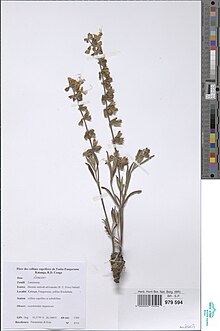Ocimum centraliafricanum
Appearance
| Ocimum centraliafricanum | |
|---|---|

| |
| Scientific classification | |
| Kingdom: | Plantae |
| Clade: | Tracheophytes |
| Clade: | Angiosperms |
| Clade: | Eudicots |
| Clade: | Asterids |
| Order: | Lamiales |
| Family: | Lamiaceae |
| Genus: | Ocimum |
| Species: | O. centraliafricanum
|
| Binomial name | |
| Ocimum centraliafricanum | |
| Synonyms | |
|
Becium homblei (De Wild) Duvign. & Plancke | |
Ocimum centraliafricanum, the copper flower or copper plant, is a perennial herb found in central Africa (DRC, Tanzania, Zambia, Zimbabwe).[1] It is well known for its tolerance of high levels of copper in the soil, and is even used by geologists prospecting for precious metals in a process called Geobotanical prospecting.[2][3]
Description
[edit]It is able to tolerate soils with copper concentrations of up to 15,000 ppm, and soils with nickel concentrations of almost 5000 ppm.[4]
References
[edit]- ^ Kew World Checklist of Selected Plant Families
- ^ John W. Miller (3 March 2013). "Mining firms discover old-timers can be worth their weight in gold". The Wall Street Journal. Retrieved 5 March 2013.
- ^ Brooks, Robert R. (1992). Noble Metals and Biological Systems: Their Role in Medicine, Mineral Exploration, and the Environment. CRC Press. p. 181. ISBN 9780849361647.
- ^ Howard-Williams, C. (1970). "The ecology of Becium homblei in Central Africa with special reference to metalliferous soils". Journal of Ecology. 58 (3): 745–763. doi:10.2307/2258533. JSTOR 2258533.
